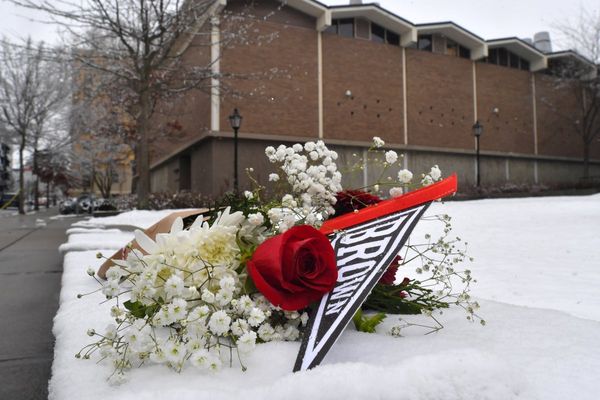For dairy farmer James McRae, the floods arrived in a perfect storm.
It had been a wet autumn on the New South Wales mid-north coast, saturating the soil, which made it hard to sow new pastures. When 200mm of rain hit overnight on Monday, low-lying farms in his community of Barrington were “completely decimated”.
One of McRae’s friends remained on his farm with his cattle for days until he had to be rescued by boat, leaving the cows behind to drown. Another, with a young family, has lost whole herds – including calves – their house and their machinery, three years after their farm was inundated in 2021.
“They’ve lost absolutely everything, just completely blank-slated,” he said. “How do you even get through that? You’ve got young farmers being impacted by this, and they’re probably thinking: ‘where do we go from here? Can we rebuild? Can we get back on track?’
“A generation of farmers are potentially going to go out of the industry.”
The vice-president of the NSW Farmers, Rebecca Reardon, said many farmers that have been hit by this week’s devastating floods were still recovering from ex-Tropical Cyclone Alfred, when paddocks had become waterlogged, making it near impossible to get pastures ready to feed their stock through winter.
“This is a horrific flood,” she said. “There’s going to be infrastructure damage, further road damage which will affect getting fresh milk to market and machinery losses, pasture losses.
“It’s too late in the season to be able to re-sow and grow pasture, because we’re going into the cold period … there’s a huge knock-on effect.
“You’re running into the hundreds of millions [in losses], and it’s going to be very difficult for some of these guys to get back on their feet.”
Then there was the personal toll. Reardon said losing livestock was “very distressing for any farmer”, and this time the flood was so high many had been unable to get their animals to higher ground.
“A lot of these guys are coming off those 2021 floods, it will be heartbreaking for some. There’s no doubt, it’s events like these which make people rethink if they can continue to farm,” she said.
As in so many natural disasters, community spirit kicked into gear.
At St Joseph’s primary school in the town of Taree, where a record deluge had inundated the Manning River, locals were taking care of five horses that were rescued by boat after becoming stranded.
Businesses were quick to offer free food and hot showers to residents who had lost their homes, while local volunteers rushed out on dinghies conducting rescues.
But despite their resilience, locals had questions as to why a natural disaster declaration wasn’t made earlier, and how it had taken so long for rescues to occur.
As of Thursday afternoon, three people had died, one remained missing and 48,000 people were isolated as the flood waters “smashed through” communities on the mid-north coast and parts of the Hunter. The NSW premier, Chris Minns, warned people were experiencing “levels of rise in local tributaries, creeks, rivers, that we haven’t seen since 1920”.
Taree resident Emma Browne said volunteer rescuers were “tired and need help”.
“The community is now launching their own boats to help rescue people still waiting for two days,” she said. “Where’s the navy, army and everyone else?”
About 20km south-east of Taree at Old Bar, Miranda Saunders was watching items wash ashore from Farquhar Inlet – one of the entrances from the Manning River.
Lounges, mattresses and chairs from churches had all spilled downstream alongside council barriers, shoes and cows, which washed up on beaches as far south as Forster.
“I know so many people that had to leave or are staying to try to save their homes,” she said. “In 2019, we had the fires. In 2021, the record floods. And now this.
“In Taree … streets are waist deep. Wingham is completely under water. A national disaster should have been declared on Tuesday afternoon … our first responders do an incredible job, but they’re overwhelmed.”
Saunders, the station manager of 2TLP 103.3 Ngarralinyi, broadcast live to the Old Bar community for 15 hours on Tuesday from her kitchen, taking song requests from families and singles who had lost their power and were relying on radios to get information.
“From 7am to 9pm, I was on air … bringing comfort, connection, and critical updates to our community during one of the toughest days we’ve faced,” she said, describing the feeling across the community as one of “absolute devastation”.
Apart from extensive road closures, she hadn’t been personally affected by the flooding, but her sister-in-law, along with her husband and four children, had to evacuate their home by boat late Wednesday as flood waters entered their home.
At the bend of the Manning River at Tinonee, Janeece Irving had just been elected to the local council on Wednesday when she evacuated her home, right next to where a ferry would cross to Taree in the 19th century.
Her house was built in the 1930s, set 6 metres above the river on a hill. In two decades living there, this was the first flood where she’d had to evacuate.
“It’s coming around over the top of my deck and under the house,” she said, speaking from her neighbour’s property which was on safer higher land.
“We’re just not prepared for this kind of flooding event … the volume of water is insane. It was just too scary for me to stay in the house – I was in fight or flight mode, I thought I was going to be washed away.”
Her house was still standing strong on Thursday afternoon, but she knew what was to come – mopping up “sticky, smelly mud”, that was full of bacteria and clung to everything.
“I’m standing out here looking at the river, and there’s this smell, like a dead animal smell coming off the river,” she said. “I’ve lived in this valley for 60 years, came here when I was two. We’re flood prone, but I’ve never seen anything like this.”
Back in Barrington, McRae considered himself lucky. Their property was set among hills, so despite pasture damage and a power outage, the cattle had survived.
He was just hoping grants provided in the 2021 floods would be available this time – which saved people from going out of business. In the meantime, his friends who had lost everything were in “no state to talk”. He feared for the PTSD, and the years of recovery ahead.
“It’s devastating,” he said. “Completely devastating.”







